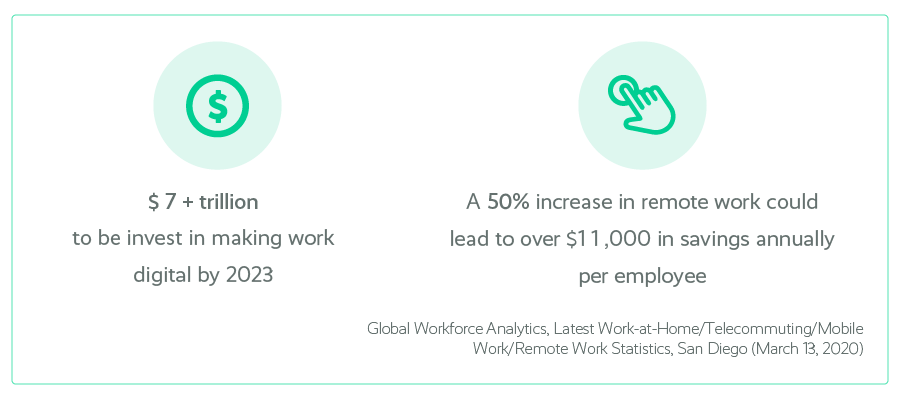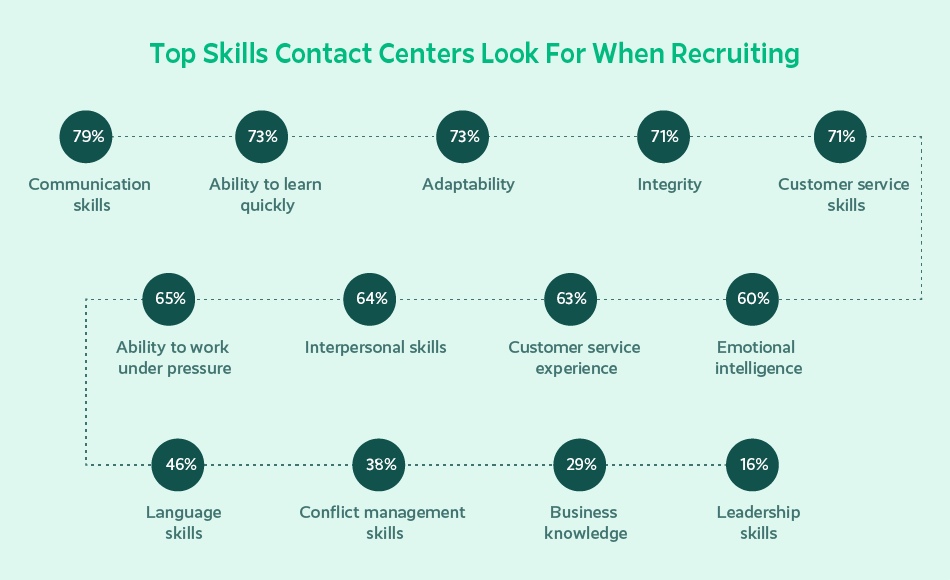How to Manage a Remote Contact Center Now: 6 Best Practices
The end of summer signals a familiar and important pivot. For many remote contact centers, it’s time to shift into a busier season, when the stakes are especially high for customer experience. Most people, including customer service agents, are ready for a restart, which makes now the perfect time for contact center leaders to revisit their remote work playbooks.
Today, Managing Well Means Means Managing Well Remotely
While some contact centers are considering a move back to a fully on-site workplace, there are clear signs remote work is here to stay—across industries and for customer experience organizations in particular. This is largely due to the measurable benefits of remote work for both employees and employers.
According to an article by KPMG, more than $7 trillion dollars will be invested in making work digital by 2023. And that’s for good reason: KPMG predicts a 50% increase in remote work could lead to over $11,000 in savings annually per employee. That means getting it right is an essential long-term customer experience imperative for remote contact center leaders.

What are Best Practices for Managing Remote Contact Center Agents?
Based on research from Playvox, which includes responses from hundreds of U.S. and Canadian contact center employees, these six management best practices will boost remote agent engagement and up your team’s customer experience game, both of which are critical to long-term success.
1. Avoid the Temptation to Micromanage
You may perceive a loss of control when your customer service team is not working in an on-site office space, where everyone is visible and in earshot. For some managers, this can result in the temptation to overcompensate by micromanaging. Resist the temptation.
In fact, the nature of remote work requires a higher degree of flexibility from you. There will be unavoidable distractions at home, even hurdles as basic as internet connection challenges. For some agents, who are new to working remotely, there may be an adjustment period. Be patient and provide support for success with their customer interactions.
For most agents in contact center environments, remote customer service center work is going well. It allows them to deliver a consistent, elevated customer experience. So, as long as hours are covered and goals are met, be flexible when dealing with your team’s needs. Give space to succeed, and your remote contact center—and customers—will benefit.
The Playvox research underscores customer support agents’ high satisfaction with remote work and, consequently, its connection to retention and recruitment:
- 70% of agents say their job happiness has increased since working remotely
- 50% of agents say they wouldn’t work for a company that didn’t offer a remote work option
- 57% say they would be extremely or very likely to leave their current job if their employer didn’t allow remote work
- 49% of contact center managers are using remote work as a recruitment and retention tool
This is universally good news for remote contact centers, their customers, and their employees.

2. Communicate More Often Than You Think You Should
According to the Playvox research findings, managers and customer service agents agree that better communication equals better engagement. Customer experience leaders say agents are best motivated and engaged through regular, meaningful communication channels, by phone and digital channels.
Just because you don’t hear from your customer service representatives doesn’t mean they don’t need your help. Unexpected problems come up, and they should know someone is available to support them when needed. Stay aware of the warning signs of underperformance or low team morale and communicate to get to solutions.
Regular one-on-one meetings with remote agents can help assess motivation levels and allow managers to quickly course-correct as needed. Creative team building and sharing are also important, according to the customer service agents surveyed
Managers report that actively monitoring remote team satisfaction elevates engagement. Remember that better communication is two-way. Gallup research reveals that lack of clarity around expectations, recognition, and connection to the business has led to lower engagement rates for remote employees compared to others.
Ensure remote contact center teams understand organizational goals and strategies, and invite them to offer input. Listen to feedback about what’s working and isn’t succeeding across the team. And show that you are taking action to address issues.
3. Recruit and Hire Wisely
Managing your remote customer service team is much easier when you hire the right people. Consider the skills you know make the most effective remote workers, including integrity, the ability to learn quickly, and adaptability.

In a competitive job market, the strongest job candidates will naturally seek out best-in-class employers. In the same way applicants strive to make themselves stand out, employers must differentiate too.
The good news is that recruiting for virtual contact center agents means you don’t have to restrict your search to local candidates, which improves access to better-qualified people. Managers in the Playvox survey cited this as an important benefit of remote work.

4. Train Well
Top-performing contact center leaders understand that ongoing agent training is critical to success. Keeping remote customer service agents motivated requires new thinking and new training approaches.
Gamification in remote workforce training is proven to be effective. One contact center that participated in the Playvox research uses a remote workforce training program called Kahoot! to create game show-type quizzes everyone can participate in remotely using Zoom.
Related Article: Best Contact Center Games to Play Remotely
When training remote contact center agents by video, record the calls so agents can watch them again later for clarity or to reinforce coaching. Remember that one-on-one training isn’t the only remote training option. Virtual classroom sessions are helpful for remote contact center teams and efficient for your organization.
Consistency is key for effectively training remote customer support agents, and a virtual classroom is a smart tactic. It’s a cost-effective way to resolve common issues, improve knowledge retention, and quickly increase productivity.
5. Optimize with Technology
Video conferencing may be the single most important tool for managing remote contact center agents. According to respondents in the Playvox research, video conferencing software like Zoom is the most popular technology used to support remote workforces (54%). But video conferencing is only the start of the technology available to support remote customer service agents and manage remote customer support teams.
For optimization, Workforce Management and Quality Management solutions are game changers. These contact center solutions address the inherent hurdles of remote work—when customer experience managers can’t quickly provide face-to-face guidance and feedback—with tools for:
- Agent evaluation
- Problem resolution
- Collaboration
- Scheduling
When managers can’t post schedules for remote customer service representatives on office whiteboards, WFM software can help based on demand and enable remote contact center agents to view their schedules and easily trade shifts from anywhere. When these solutions are cloud-based, they can simplify and change on demand.
Spreadsheets and other manual processes were not designed for the inherent complexities of a remote contact center’s staffing needs. Step up to a more advanced contact center solution.
Related Article: What is WFM (And How Does It Apply to Our Daily Lives)?
6. Manage with a Learner’s Heart
A small but important shift toward optimizing your teams and the overall performance of your remote contact center is a willingness to listen and make changes when possible and necessary. Flexibility is now a priority for employees. For contact centers to retain the caliber of employees they need to win and keep customers, they must adapt.
Use hard performance data and anecdotal data collected from your experiences with your remote customer service agents to improve. For example, data from the Playvox research indicates remote customer support agents have a strong desire to continue working remotely. This data was very clear. Like with everything you learn, determine what it means for your remote contact center.
Understand the State of the Remote Workforce to Manage Better
Now is an opportune time to make changes for the better at your remote contact center.
To help improve how you manage your remote contact center agents for a better customer service experience, learn more from the real-life experiences of other remote contact center managers and agents. Read the complete research findings in Playvox’s ebook, The State Of Remote Work In The Contact Center Industry.






